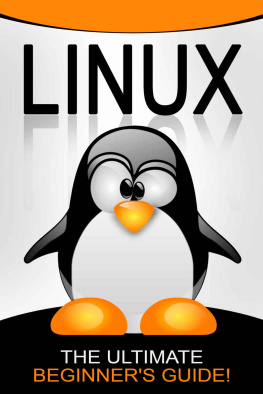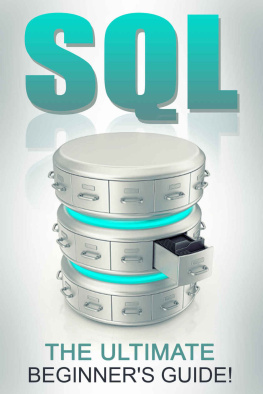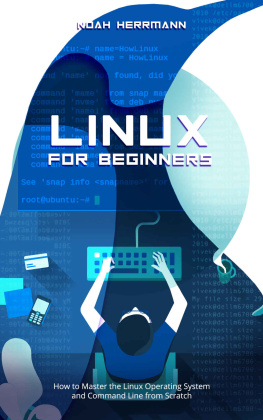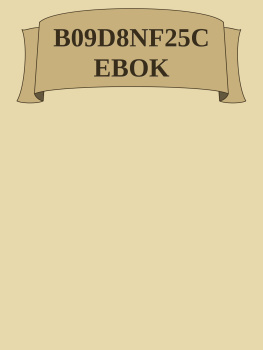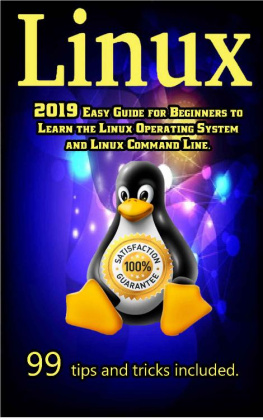Johansen - LINUX: The Ultimate Beginners Guide!
Here you can read online Johansen - LINUX: The Ultimate Beginners Guide! full text of the book (entire story) in english for free. Download pdf and epub, get meaning, cover and reviews about this ebook. year: 2015, genre: Computer. Description of the work, (preface) as well as reviews are available. Best literature library LitArk.com created for fans of good reading and offers a wide selection of genres:
Romance novel
Science fiction
Adventure
Detective
Science
History
Home and family
Prose
Art
Politics
Computer
Non-fiction
Religion
Business
Children
Humor
Choose a favorite category and find really read worthwhile books. Enjoy immersion in the world of imagination, feel the emotions of the characters or learn something new for yourself, make an fascinating discovery.
LINUX: The Ultimate Beginners Guide!: summary, description and annotation
We offer to read an annotation, description, summary or preface (depends on what the author of the book "LINUX: The Ultimate Beginners Guide!" wrote himself). If you haven't found the necessary information about the book — write in the comments, we will try to find it.
LINUX: The Ultimate Beginners Guide! — read online for free the complete book (whole text) full work
Below is the text of the book, divided by pages. System saving the place of the last page read, allows you to conveniently read the book "LINUX: The Ultimate Beginners Guide!" online for free, without having to search again every time where you left off. Put a bookmark, and you can go to the page where you finished reading at any time.
Font size:
Interval:
Bookmark:
LINUX
The Ultimate Beginners Guide!
Copyright 2015 - All rights reserved.
This document is geared towards providing exact and reliable information in regards to the topic and issue covered. The publication is sold with the idea that the publisher is not required to render accounting, officially permitted, or otherwise, qualified services. If advice is necessary, legal or professional, a practiced individual in the profession should be ordered.
- From a Declaration of Principles which was accepted and approved equally by a Committee of the American Bar Association and a Committee of Publishers and Associations.
In no way is it legal to reproduce, duplicate, or transmit any part of this document in either electronic means or in printed format. Recording of this publication is strictly prohibited and any storage of this document is not allowed unless with written permission from the publisher. All rights reserved.
The information provided herein is stated to be truthful and consistent, in that any liability, in terms of inattention or otherwise, by any usage or abuse of any policies, processes, or directions contained within is the solitary and utter responsibility of the recipient reader. Under no circumstances will any legal responsibility or blame be held against the publisher for any reparation, damages, or monetary loss due to the information herein, either directly or indirectly.
Respective authors own all copyrights not held by the publisher.
The information herein is offered for informational purposes solely, and is universal as so. The presentation of the information is without contract or any type of guarantee assurance.
The trademarks that are used are without any consent, and the publication of the trademark is without permission or backing by the trademark owner. All trademarks and brands within this book are for clarifying purposes only and are the owned by the owners themselves, not affiliated with this document.
Table of Contents
Introduction
Chapter 1: Linux The Basics
Chapter 2: Basic Functions
Chapter 3: The File System
Chapter 4: The Processes
Chapter 5: The I/O Redirection
Chapter 6: Linux Systems and Text Editors
Chapter 7: Networking
Conclusion
Introduction
I want to thank you and congratulate you for purchasing this book
LINUX: The Ultimate Beginners Guide!
This book will teach you how to use Linux operating systems. After reading this material, youll be able to use Linux for both basic and advanced purposes. Aside from explaining basic concepts and theories, this book will give you practical tips and actual commands. That means you can be a proficient Linux user just by reading this book.
Each chapter is dedicated to an important aspect of Linux. For instance, a chapter is dedicated to the file system being used by Linux machines. With this kind of data presentation, you wont have to waste your time reading about irrelevant topics.
Study this book thoroughly because it can help you maximize your Linux computer/s.
Thanks again for purchasing this book, I hope you enjoy it!
Chapter 1: Linux The Basics
What is Linux?
Linux is an operating system (OS). It is a type of software that allows users and computer programs to interact with the machine (e.g. access the devices needed to perform certain tasks). The operating system forwards commands from a computer program to, for example, the PCs processor. The processor conducts the given task, and transmits the data back to the program using the OS. Linux is like other operating systems, such as Windows and Mac OS.
In addition, Linux is an open-source operating system. That means every user may check the softwares code and improve it no single company is exclusively responsible for its continuous development and support. Businesses participating in the Linux project share research and development expenses with other organizations (e.g. partners, competitors, etc.). This distribution of responsibilities amongst groups and individuals has resulted in amazing software development and efficient working ecosystem.
Linux One of the Leading Operating Systems
Now, Linux is one of the top players in the OS market. At first, Linux developers focused on networking and basic services. They didnt create office applications during the OSs first few years of existence. But now, these developers have created many alternatives to the programs included in Microsofts Office Suite. These new computer programs are designed to make Linux a great workstation. Aside from its user-friendly interface, Linux operating systems have Microsoft-compatible office programs such as presentations, spreadsheets, word processors, etc.
In terms of servers, Linux is a stable and efficient platform it provides trading and database services for businesses such as Amazon and US Post Office. ISPs (internet service providers) like Linux because of its proxy, firewall, and web server capabilities. Finally, arrays of Linux computers were used to create famous motion pictures (e.g. Shrek, Titanic, and many others).
The User Interface of Linux
Whether this OS is difficult to learn depends on the user you are talking to. Experienced users will certainly say no, since Linux is a great operating system for programmers and power-users. In addition, it has been checked and improved by thousands of computer experts.
Linux provides programmers with everything they need: libraries, compilers, and debugging/development tools. These features are included in all standard Linux versions. You will also get the C-compiler for free unlike most Unix systems that demand licensing fees. All of the manuals and documentations are included, and examples are usually given to help beginners in getting started. Because of this, switching between Unix and Linux is an easy and natural thing.
Linux and Inexperienced Users
Businesses such as SuSE, Mandriva and RedHat have been established, offering packaged distributions of Linux systems for public users. They combined many GUIs (graphical user interface), created and improved by the community, to streamline the usage and management of services and programs. As a modern Linux user, you have all the necessary tools to understand your operating system completely. However, deep knowledge is no longer needed before you can use the Linux system. Even beginners can use this OS with considerable ease.
These days, you can sign in graphically and begin all the needed programs without even entering a single key. Linux system allows you to access the systems core quickly and easily. Because of this setup, you can become familiar the basics of this OS: Linux is great for beginners and expert users. Inexperienced users dont need to do difficult stuff, and expert users dont have to use basic features.
Heres a screenshot of a Linux spreadsheet:

The Pros and Cons of Linux
In this section, we will discuss the pros and cons of using a Linux operating system.
The Pros
- It is free If you dont want to spend anything for your computers OS, then this is the best software for you. You dont have to purchase a CD just to get this powerful operating system. In fact, you can just go online and download Linux - FOR FREE. With this OS, you wont have to worry about registration fees, update costs, and premium source codes.
- It can be used with any hardware A merchant who wants to sell a new PC but doesnt know what type of OS the computer will run, can get a Linux kernel and use it for his hardware. He wont experience any problems since tutorials and manuals are available for free.
- It is designed to stay running Just like Unix, Linux systems are designed to keep on running without the need for a reboot. This is the reason why many tasks are performed at night or assigned automatically. This results in improved computer availability during busy periods and better balance in terms of hardware usage. This feature enables Linux to be appropriate in working areas where individuals dont have the time or resources to manage their machines 24/7.
Font size:
Interval:
Bookmark:
Similar books «LINUX: The Ultimate Beginners Guide!»
Look at similar books to LINUX: The Ultimate Beginners Guide!. We have selected literature similar in name and meaning in the hope of providing readers with more options to find new, interesting, not yet read works.
Discussion, reviews of the book LINUX: The Ultimate Beginners Guide! and just readers' own opinions. Leave your comments, write what you think about the work, its meaning or the main characters. Specify what exactly you liked and what you didn't like, and why you think so.

